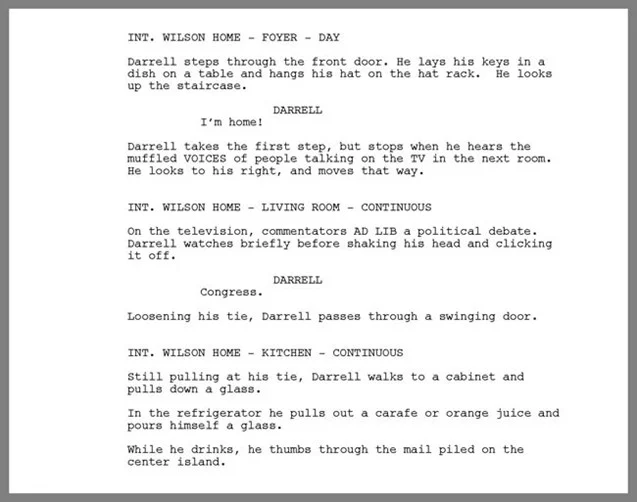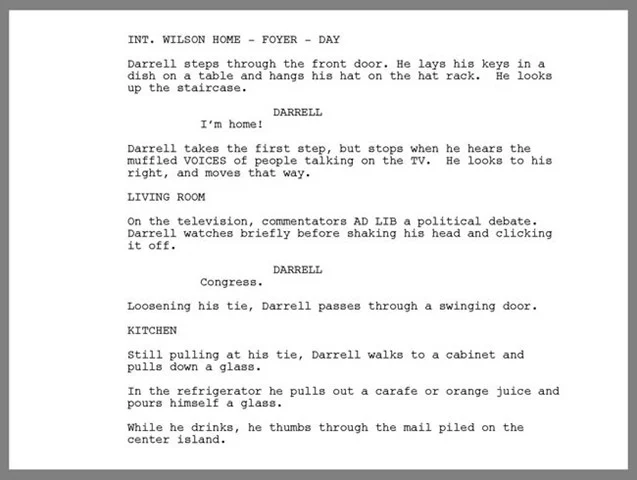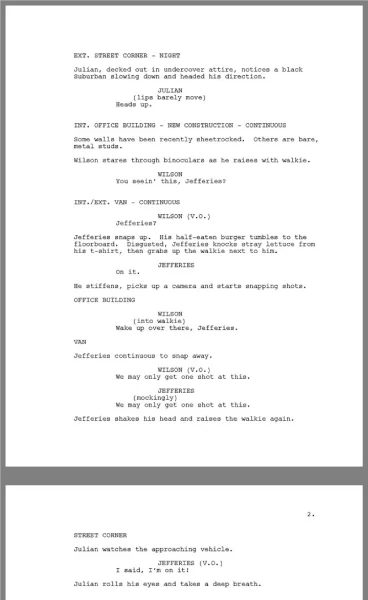
Screenwriting ABCs Script Formatting
Using Subheadings for Continuous Action
by T. J. Alex
Book Excerpt, 3 pages
Viewed by: 26 Residents and 208 Guests

Using Subheadings for Continuous Action
Easily one of the most useful functions of Subheadings is their ability to move characters from one location to another continuously through a larger location of a Master Scene Heading.
Look at this example, paying particular attention to the Scene Headings:

The above example is correct, as far as formatting is concerned, but tiresome to a reader nonetheless.
Why?
Because it constantly repeats information unnecessarily, such as the fact each locale takes place in the WILSON HOME and that the action from one locale to the next is CONTINUOUS, meaning there is no loss of time as the character moves from room to room.
These facts are implied by the context of the scene, so there is no reason for new Master Scene Headings as the character moves through the home.
Subheadings allow writers to call out room changes without repeating unnecessary information, making for leaner writing and saving valuable page space since the Master Scene Headings above are triple-spaced, and Subheadings are always double-spaced.
Here is the same scene, but with Subheadings:

Much better.
Non-continuous Action:
Subheadings also work the same way if the action is not completely continuous. Look at this scene from the Subheading Basics section:

In this example, the action in NOT continuous. Had the writer opted to use Master Scene Headings, he/she might have typed MOMENTS LATER rather than CONTINUOUS. But Subheadings work fine to help move the scene along.
Interrelated Locations:
Sometimes a writer might have a series of locations within the same scene with continuous action happening between them.
Let's say we have a scene with three different locations, all in close proximity to one another. Now there's nothing wrong with using a Master Scene Heading to move between each and every scene, but it also becomes unnecessary.
Once all three locations are established with Master Scene Headings, the writer may move from one to the next using Subheadings.
Look at this lengthy example, but please excuse the small type:

Now we could have also used an Intercut to move between locations, but I've found that when more than two locations are involved, Intercuts, without a Subheading to keep the reader oriented, can get confusing.
Again, notice I used full Master Scene Headings to establish each of the locations, but once that was completed, I used Subheadings to move between the locations.
Of course, had these locations not all been part of the same scene, the use of Subheadings to move between them wouldn't have been possible.
-----------------------------
For more screenplay formatting rules and advice, check out the book, Your CUT TO: Is Showing! by T. J. Alex or visit www.scripttoolbox.com. From there, please like the page on Facebook, and share it with your friends.
If you have any formatting questions, please email T. J. at tj@tjalex.com.




